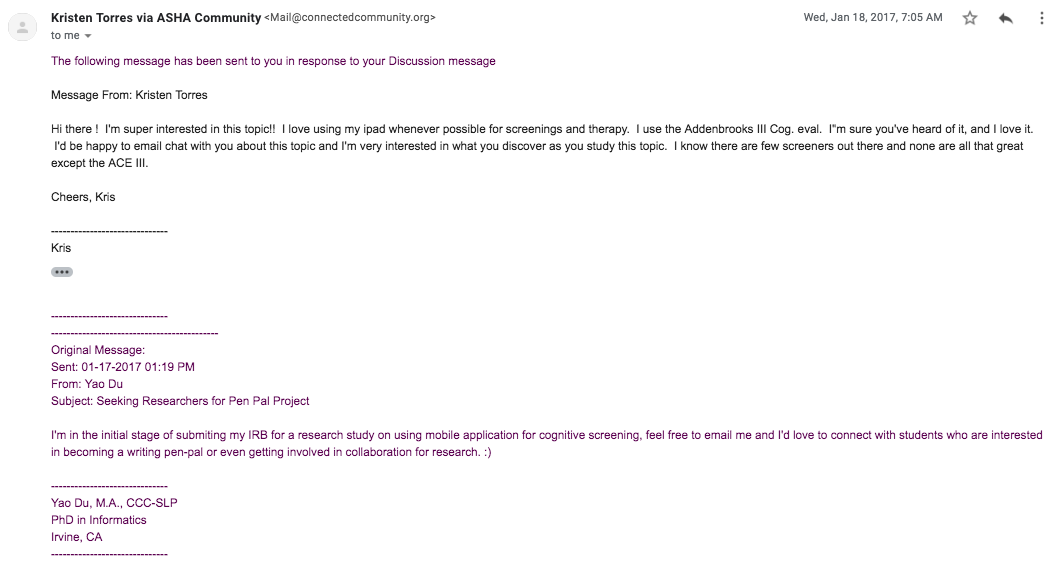More than two years ago, Yao (a full-time speech therapist) and David (a dad of two children and a part-time teacher) began a new journey: the creation of eSLUMS. Without any prior background in app design and development, this is our first joint adventure (literally by faith in God) towards creating an iOS app, hoping to improve clinicians’ practice of administering cognitive screening among aging adults who are at risk for cognitive impairments and dementia. After two years, we have thousands of users, and eSLUMs has been downloaded by users all over the world, including researchers like Dr. Kristen K. Torres, a newborn doctor of clinical science (in 2018) in speech language pathology at the Rocky Mountain University of Health Professions.
Kristen and Yao met (virtually) through a pen-pal post in the American Speech-Language and Hearing Association (ASHA) online community way back in early 2017 (see screenshot below, the good old days). Over the years, Kristen has been a wonderful supporter for eSLUMS since the initial beta-testing phase until recent update and social media promotion. Yao lives in California and Kristen lives in New Mexico, these two never meet each other and are both in the process of pursuing a doctoral degree. It is through these small incremental steps of working together as an app designer and a user, that these two developed virtual friendship supporting each other and sharing the passion about using technology to improve clinical services of speech language pathology.

In her dissertation study titled “The Effect of CTAR Exercises for Dysphagia in Persons with Oculopharyngeal Muscular Dystrophy,” Kristen used our app eSLUMS as a cognitive screening measure as part of her inclusion/exclusion criteria. The study itself was to assess the efficacy of swallowing exercises for people with oculopharyngeal muscular dystrophy, a genetic disease that causes weakness in the pharyngeal musculature and dysphagia. The study participants had to have sufficient cognitive and memory skills to to complete the exercise regime for the study and Dr. Torres used the eSLUMS to screen for these skills. She believes that compared to the paper-based SLUMS, “the app version reduced variability in administration as the questions are stated exactly the same way each time and the scoring is automatic” (Torres 2018, p.43). Kristen has kindly agreed to let Yao share a copy of her dissertation, in case anyone is interested in learning and reading more about her work. The eSLUMS team also was able to conduct a brief email interview with Kristen about her dissertation study.
Tell me about your background and your dissertation study?
I am an SLP in practice for 32 years, all of them in the medical field although I have concurrent experience in home health, schools and tele-therapy. Since I live in an area where OPMD occurs frequently I have a special interest in treating it. I completed my doctoral capstone on the topic of using the Chin Tuck Against Resistance (CTAR) exercise to see if it helps the dysphagia. I used the SLUMS as part of my screening for participants for the study.
What made you choose eSLUMs instead of the original SLUMS?
I am a techie geek and I love to use my iPad whenever possible. I liked the eSLUMS because it was handy to have, did not require paper and pencil, and was consistent to score each time. I always opt for an iPad version of whatever I am using if it is as reliable and easy as the paper version. I felt that giving the test across time and participants was more reliable via the iPad version.
How was your experience using eSLUMS during your study with your users?
My users were all elderly yet they were able to comfortably complete the eSLUMS with no problems. I used paper and pencil sometimes for the clock drawing because I felt the iPad screen for that portion was a little small and hard for them to draw on with wobbly hands. My experience using it was very positive as I always had access to their scores without looking up the paper version in each individual file folder.
What would you say to other other researchers who may use eSLUMS in their future work?
Consistency is key in any kind of research and in therapy as well. Using the same exact protocol, lead by the eSLUMS, makes your administration much easier and more consistent from patient to patient and from admin to admin in the same patient. Its always handy in your iPad and its very user friendly. I would recommend using it for research purposes unless there was some compelling reason that the participant could not interact with the iPad itself.
If you are a practitioner or researcher who is interested in utilizing eSLUMs for research or your personal practice, please email the eSLUMS team and we love to hear from you!

Hi, I have used eSLUMS which is an interesting dementia screening app. I just wonder can you please let me know what are the screening methods that your app is based on if any. Is it just one, or a combination of methods or have you designed the questions by yourself? I appreciate your response.
Regards,
Eman